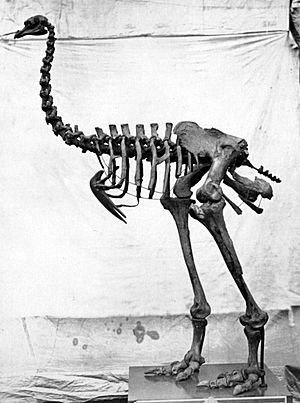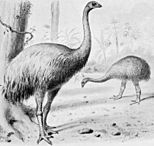Pachyornis facts for kids
Quick facts for kids PachyornisTemporal range: Late Pleistocene-Holocene
|
|
|---|---|
 |
|
| P. elephantopus skeleton photographed by Roger Fenton | |
| Scientific classification |
|
| Kingdom: | Animalia |
| Phylum: | Chordata |
| Class: | Aves |
| Order: | †Dinornithiformes |
| Family: | †Emeidae |
| Genus: | †Pachyornis (Lydekker, 1891) |
| Species | |
|
Pachyornis elephantopus Heavy-footed Moa |
|
Pachyornis was a type of moa, a large, extinct bird that couldn't fly. These birds lived in New Zealand. Like all moa, Pachyornis was a ratite, which means it had a flat sternum (breastbone) without a keel, unlike flying birds. This genus included three known species, with the most famous being the Pachyornis elephantopus, also known as the Heavy-Footed Moa.
Meet the Heavy-Footed Moa
Pachyornis moa were known for being very strong and having thick, heavy legs. They were generally similar to other moa, like the Eastern Moa or the Broad-billed moa. However, Pachyornis had a pointed beak and a more solid body shape. One species, P. australis, might have even had a crest of long feathers on its head!
Why Did Pachyornis Disappear?
Sadly, Pachyornis moa became extinct very quickly after humans arrived in New Zealand. People hunted them, and their habitats changed, leading to their disappearance. One skeleton of P. australis was found and dated to between 1396 and 1442. This shows that some moa were still around just before or during the first human settlements.
New Discoveries About Pachyornis
Scientists have recently found evidence of two new types of Pachyornis using genetic studies. These new groups might become new species one day. One was found in New Zealand's North Island, and the other in the South Island. These discoveries help us learn even more about these amazing ancient birds.
-
Restoration of Dinornis giganteus and Pachyornis elephantopus, both from the South Island


